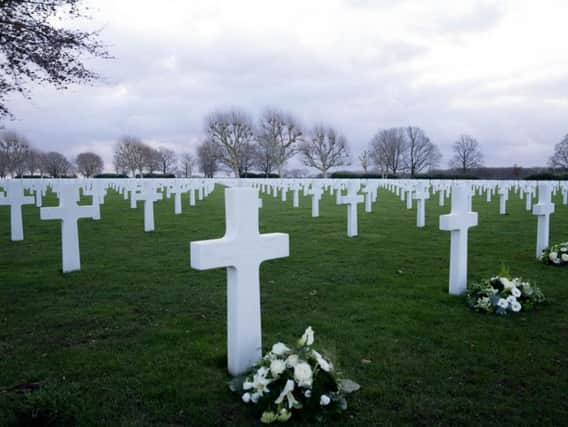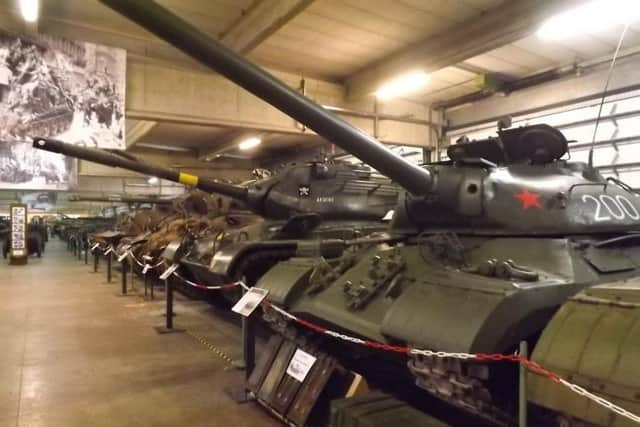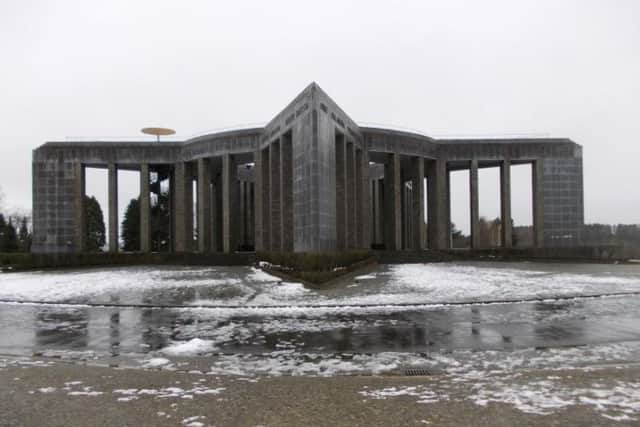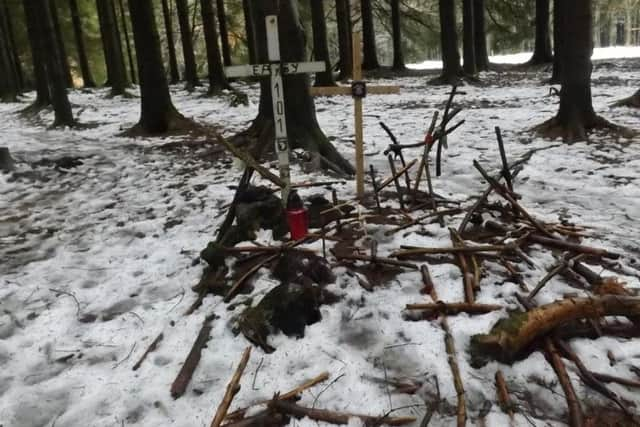Europe prepares to celebrate 75 years of freedom from Nazi occupation


I was fortunate enough to be invited by the Liberation Route Europe Foundation to view some of the sites that culminated in the Ardennes Offensive which history now refers to as the Battle of the Bulge.
Fought primarily in the area around the Ardennes Forests and the strategic Belgian town of Bastogne, both sides were to suffer enormous casualties in a six week battle that started in December 1944.
Advertisement
Hide AdAdvertisement
Hide AdHaving transferred from Brussels where I had attended a special Liberation Route Europe conference, I arrived in Bastogne with five fellow guests to stay overnight at the Melba Hotel.


The following morning we transferred to the nearby Bastogne Barracks run by the War Heritage Institute where we had a guided tour and presentation courtesy of Bruno Lacluyse.
It's a truly amazing museum, displaying simply dozens of British, US, Russian and German tanks together with all manner of military vehicles and weaponry. And it's no wonder that the barracks will feature strongly in the 75th celebrations later this year when it is expected to be visited by some of the surviving veterans who fought in the Battle of the Bulge who will be accompanied by their families.
"I love it when you see Battle of the Bulge veterans greet each other like old friends," said Bruno. "I remember watching these two," he smiled, pointing to one particular picture on a wall lined by thousands of portraits.
Advertisement
Hide AdAdvertisement
Hide Ad"It's Frank Hartzell of the US 11th Armoured Division greeting Gunther Fiehl of 15 Panzer Grenadier Division and it went something like 'I remember it was bitterly cold' with the German's reply being exactly the same. They were referring to the nighttime temperature which during the battle dropped as low as minus 20C degrees."


Bruno also gave us a tour of the whole barracks area including the restoration workshops where hundreds of military vehicles are being readied for a special parade this November when thousands of visitors are expected to join in the 75th anniversary celebrations.
Making the short trip north accompanied by tour guide Joël Lamberty, the snow-covered foxholes dotted around Belgium's Ardennes Forest were turned into shallow graves for so many Allied soldiers in December 1944 as they attempted to repel the last major German Wehrmacht offence of the Second World War.
With minimum weaponry and totally inappropriate clothing, the men were marched ten kilometres in freezing conditions and told to dig in alongside a road opposite the German front line.
Advertisement
Hide AdAdvertisement
Hide AdThe rapid Allied advance from Normandy had finally stalled in the Belgian Ardennes due to heavy German resistance and, while the south of Limburg had been liberated, the weather clearly played a huge part in what was to come.


With superior firepower, three huge armoured Panzer divisions were aided by some of the worst weather conditions of the Second World War and the Germans were to break through and surround the town of Bastogne in southern Belgium.
Of paramount importance to the Allies, the US 101st Airborne Division led by Brigadier General Anthony McAuliffe was ordered to hold the town at all costs and, after setting up headquarters in Bastogne Barracks, they somehow held firm. The Germans sent a written request to seek a surrender, but McAuliffe entered the history books by sending back a one word answer - it read 'Nuts' in response to the request.
The Ardennes Offensive or Battle of the Bulge lasted for six weeks and proved to be the costliest operation ever fought by the US Army. It left 10,733 American soldiers dead and another 42,316 wounded while the German losses totalled 12,652 killed and 38,600 wounded. Added to that, around 2,500 civilians also lost their lives in Belgium while another 500 perished in the nearby Grand Duchy of Luxembourg.
Advertisement
Hide AdAdvertisement
Hide AdFollowing Bastogne Barracks and Ardennes Forest encounter, we visited Bastogne War Museum where several hundred children were actively involved in school projects. My American colleague was intrigued and messaged her 22-year-old daughter back in the States asking: "What do you know about the Battle of the Bulge?" to which the response was: "It was a war, but it's no longer relevant to life!" Naturally my colleague was dumbstruck!
However she asked the same question of her two sons (aged 14 and 18) when she returned to Colorado and they also knew absolutely nothing about what had been a key battle for the American troops.
The museum has three multi-dimensional stage settings in which visitors relive the lives of four main characters – a child, a Belgian housewife, a German officer and an American soldier – all having been at the heart of the action.
Just a stone's throw from the museum is the huge Mardasson Memorial which the Belgian's erected in a four year period after the hostilities had ended to commemorate the sacrifices made by the Allied troops.
Advertisement
Hide AdAdvertisement
Hide AdFrom Bastogne we travelled east into the Netherlands to the town of Norbeek, having stopped en route to visit the Mesch Memorial. The village of Mesch was the first in the Netherlands to be liberated on 12th September 1944 by the 30th American Infantry Division which was affectionately nicknamed 'Old Hickory'.
Staying at the delightful family-run Herberg Sint Brigida Hotel, our hosts were Brigitte and Frans van Wissen while we learned about the history of the enormous US War Cemetery at nearby Margraten where more than 20,000 Allied and German bodies were laid to rest. Then almost three years later, more than 10,000 US soldiers and over 3,000 Germans were exhumed by prisoners of war and repatriated back to America and to Germany.
That night Mieke Kirkels, a Dutch author and public historian, gave a talk about the establishment of Margraten where she discovered hundreds of African-American liberators were not officially recognised as they had only been used as transport drivers or for digging graves.
The following morning we visited Margraten itself were cemetery superintendent Shane Williams explained that following the exhumations, there are now just 8,301 American military graves.
Advertisement
Hide AdAdvertisement
Hide AdOur Battle of the Bulge trip ended with a short visit to the Eyewitness War Museum at Beek (pronounced 'Back') where there are 13 dioramas depicting different war scenes thanks to 150 lifelike mannequins all correctly dressed in salvaged uniforms.
Guided round by the knowledgeable Merijn Bevers, the fictional main character of the museum is German parachutist August Segel who takes visitors along the most important fronts in Europe, one of them being the Battle of the Bulge.
You can follow his story through letters back to this family at home. These letters are based on true stories and thanks to the German angle, it gave us another perspective on the Battle of the Bulge.
FACT FILE
Motel One Brussels
Rue Royale 120, 1000 Brussels, Belgium – https://www.motel-one.com/en/hotels/brussels/hotel-brussels/Hotel Melba
Advertisement
Hide AdAdvertisement
Hide AdAvenue Mathieu 49-51, B-6600 Bastogne, Belgium – https://hotel-melba.eu/en/Herberg Sint Brigida
Dorpstraat 36, 6255 AN Noorbeek, The Netherlands Hosts Brigitte en Frans van Wissen – http://www.herbergsintbrigida.nl/
PLACES VISITED
Liberation Route Europe Conference at the Claridge, Chaussée de Louvain 24, 1210 Brussels – https://b2b.liberationroute.com/conference/Bastogne Barracks (War Heritage Institute) – http://www.bastogne-barracks.be/300-2/?lang=enBastogne War Museum – http://bastognewarmuseum.be/home.htmlMesch Memorial – audio spot ‘Welcome in Holland’ – https://liberationroute.com/the-netherlands/pois/w/welcome-in-hollandMargraten American War Cemetery – https://bit.ly/2roMfPp and https://bit.ly/2Tl9ypJWar Museum Eyewitness, Beek, The Netherlands – https://www.youtube.com/watch?v=rkg5eg0G-y8 and https://www.eyewitnesswo2.nl/https://liberationroute.com/the-netherlands/spots/e/eyewitness-museum*** Many thanks to Gert-Jan Jacobs, Communications Manager for the Liberation Route Europe for the kind invitation and for arranging the visit.